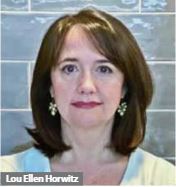The urgent care model continues to evolve as patient needs and technologies emerge
January 2022 – The Journal of Healthcare Contracting

The Urgent Care Association (UCA) is an organization of leaders, providers and suppliers in on-demand healthcare. It supports success through advocacy, education, research and collaboration. Its CEO Lou Ellen Horwitz recently spoke with JHC about the organization, some of the biggest changes in the urgent care marketplace since its inception in 2004 and how urgent care centers were affected by the pandemic.

JHC: The Urgent Care Association was started in 2004. Can you tell us the reason behind its creation, and the number of initial members?
Horwitz: UCA was started by a group of urgent care owners who wanted to connect with and share best practices with other owners across what was then a nascent industry. Urgent care was the first “walk-in” medicine outside of the emergency room, which added the element of patient choice and patient experience into an existing ecosystem of how we delivered healthcare in the U.S. Initially, there were a few hundred members – we do not have an exact count.
JHC: What are some of the biggest changes in the marketplace since 2004 that UCA has helped its members navigate?
Horwitz: The biggest changes have been the introduction of retail clinics (drugstores), the interest in our sector by external investors from private equity to large health insurers, and the growing presence of health system ownership.
The introduction of retail clinics was initially met with concern about fragmenting the walk-in care space, but it became clear that urgent care centers and retail clinics have different scopes and goals and can work well together in a community.
The investments have led to exponential growth in the number of centers, increased sophistication in operations, and increased visibility of urgent care centers across the nation by all stakeholders. Health system ownership – either directly or through JV-type relationships – has grown from almost nothing to almost half the industry.
JHC: Walk through the most common ownership models.
Horwitz: The most common ownership model is through health systems or closely affiliated. Some de novo but mostly through acquisition or joint ventures. The second most common is privately held with private equity backing. Some of these also have health system affiliations without ownership. And third is privately held by individual owners – single/double site locations make up almost half of the centers in the country.
JHC: When did you begin to see health systems take an interest in acquiring/owning urgent care centers?
Horwitz: Health systems first tried urgent care in the mid-1990s but backed away after limited success. Interest resurged in approximately 2010 when acquisitions began in earnest, but in a different model from the 1990s version. It has met much more success.
JHC: Where do today’s urgent care centers fit in services and care for patients? What are their strengths?
Horwitz: Urgent care centers handle a wide variety of non-emergent illness and injury on a walk-in or appointment basis. Their scope is typically well beyond that of a retail clinic, somewhat beyond a primary care office, and slightly under an emergency room.
Their strengths begin with good medicine and safe patient care, of course, but their distinctive elements are a broad scope of care capabilities and an elemental focus on the patient experience. This has led to extremely high patient satisfaction with the model because systems are set up to make it easy and convenient to access high-quality care across a wide variety of conditions.
JHC: How were urgent care centers affected by the pandemic?
Horwitz: Urgent care centers were tremendously affected – both medically and financially. Visit volumes have tripled or more and remain at extraordinary levels even today. Operationally, they had to navigate:
- PPE shortages
- Varying medical guidance
- Confused and unhappy patients
- Fluctuating requirements for physical plant changes
- Variations in regulations from state to state
- Staffing shortages
- Inconsistent payer reimbursement for visits
- Instantaneous telemedicine adoption and more
In some ways it has been an opportunity for urgent cares to show what they can do, from their ability to adapt and pivot quickly, to form partnerships easily, and to stay open in extremely difficult circumstances. The willingness to jump in and participate from day one of the pandemic has been lauded by federal and state stakeholders, who were unaware of urgent care’s significant role in communities prior to the pandemic.
JHC: What do you forecast the marketplace to look like in five years? Ten years?
Horwitz: Urgent care has long adapted to, and even led through, change throughout its existence. It’s a model for forward-thinking care and continues to evolve as consumer needs and technologies emerge. Adoption of telemedicine, in some form, is fairly ubiquitous and geographically there are still underserved communities that could benefit from urgent care.
The payer landscape, however, has not yet caught up with the potential of urgent care to serve rural communities and lower overall costs of care from treating the non-emergent cases currently seen in the emergency room. Experimentation with hybrid urgent care/primary care models continues, as does the primary care shortage, so there is potential there as well.
Value-based care has yet to include urgent care, but it’s a natural opportunity to proactively move non-emergent care into lower cost sites, so it’s expected in the future. Private equity interest remains strong, as does consolidation via merger and acquisition activity. With the right shifts from the payer community, urgent care’s potential is promising for many years to come.
